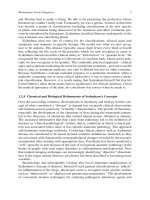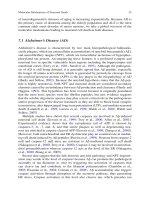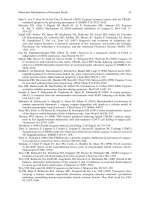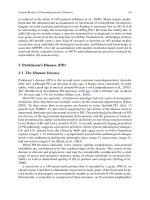Neurochemical Mechanisms in Disease P63 doc
Bạn đang xem bản rút gọn của tài liệu. Xem và tải ngay bản đầy đủ của tài liệu tại đây (161.82 KB, 10 trang )
Brain Protein Oxidation in Alzheimer’s Disease 605
Wang HY, Lee DH, D’Andrea MR, Peterson PA, Shank RP, Reitz AB (2000) beta-Amyloid(1-42)
binds to alpha7 nicotinic acetylcholine receptor with high affinity. Implications for Alzheimer’s
disease pathology. J Biol Chem 275:5626–5632
Wang J, Markesbery WR, Lovell MA (2006) Increased oxidative damage in nuclear and mitochon-
drial DNA in mild cognitive impairment. J Neurochem 96:825–832
Winterbourn CC, Buss IH (1999) Protein carbonyl measurement by enzyme-linked immunosorbent
assay. Methods Enzymol 300:106–111
Xia Y, Dawson VL, Dawson TM, Snyder SH, Zweier JL (1996) Nitric oxide synthase generates
superoxide and nitric oxide in arginine-depleted cells leading to peroxynitrite-mediated cellular
injury. Proc Natl Acad Sci U S A 93:6770–6774
Yatin SM, Varadarajan S, Butterfield DA (2000) Vitamin E Prevents Alzheimer’s Amyloid beta-
Peptide (1-42)-Induced Neuronal Protein Oxidation and Reactive Oxygen Species Production.
J Alzheimers Dis 2:123–131
Yatin SM, Varadarajan S, Link CD, Butterfield DA (1999) In vitro and in vivo oxidative stress asso-
ciated with Alzheimer’s amyloid beta-peptide (1-42). Neurobiol Aging 20:325–330; discussion
339–342
Yu HL, Chertkow HM, Bergman H, Schipper HM (2003) Aberrant profiles of native and oxidized
glycoproteins in Alzheimer plasma. Proteomics 3:2240–2248
Zamora R, Vodovotz Y, Aulak KS, Kim PK, Kane JM 3rd, Alarcon L, Stuehr DJ, Billiar TR (2002)
A DNA microarray study of nitric oxide-induced genes in mouse hepatocytes: implications for
hepatic heme oxygenase-1 expression in ischemia/reperfusion. Nitric Oxide 7:165–186
Zhou XZ, Kops O, Werner A, Lu PJ, Shen M, Stoller G, Kullertz G, Stark M, Fischer G, Lu KP
(2000) Pin1-dependent prolyl isomerization regulates dephosphorylation of Cdc25C and tau
proteins. Mol Cell 6:873–883
Oxidative Stress and Alzheimer Disease:
Mechanisms and Therapeutic Opportunities
Siddhartha Mondragón-Rodríguez, Francisco García-Sierra,
Gemma Casadesus, Hyoung-gon Lee, Robert B. Petersen,
George Perry, Xiongwei Zhu, and Mark A. Smith
Abstract Oxidative stress is an early event in the development of Alzheimer dis-
ease (AD), preceding classic fibril formation which eventually deposits as amyloid-β
senile plaques and neurofibrillary tangles composed of tau protein. Mitochondrial
and metallic abnormalities are likely precursors of oxidative stress during the early
stages of AD and, under degenerative conditions, the capacity of neurons to main-
tain redox balance decreases and results in mitochondrial dysfunction, a critical
organelle involved in AD progression. Fibril formation, including amyloid-β pro-
duction and tau phosphorylation, can be explained as a compensatory mechanism
that may eventually enhance oxidative stress by increasing reactive oxygen species
levels among many other free radicals. In this scenario, deposition of Aβ in the
extracellular environment and tau protein in the intracellular environment can be
explained as a redox imbalance with tragic consequences. If this hypothesis is cor-
rect, pharmacological treatments directed against amyloid-β or tau may not provide
a benefit. In contrast, antioxidant strategies may be helpful in treating AD symp-
toms, although significant extended benefits have not been realized to date. In
sum, the damage observed in the brain tissue of AD patients may be minimized
with a healthy daily diet, exercise, and intellectual activities, factors that all reduce
oxidative stress.
Keywords Alzheimer disease · Amyloid-beta · Antioxidants · Fibrils ·
Mitochondria · Oxidative stress
Contents
1 Introduction 608
2 Oxidative Stress, Genetics, and Alzheimer Disease Pathology
608
2.1 Fibrillary Aggregates and Oxidative Stress
610
2.2 Amyloid-β Peptide
610
M.A. Smith (B)
Department of Pathology, Case Western Reserve University, Cleveland, OH 44106, USA
e-mail:
607
J.P. Blass (ed.), Neurochemical Mechanisms in Disease,
Advances in Neurobiology 1, DOI 10.1007/978-1-4419-7104-3_18,
C
Springer Science+Business Media, LLC 2011
608 S. Mondragón-Rodríguez et al.
2.3 Tau Protein
612
3 Oxidative Stress and Metabolism
613
3.1 Energy Utilization
614
3.2 Mitochondria
614
3.3 Metals
615
4 Current and Future Pharmacological Treatments for Alzheimer Disease
616
5 Conclusion
619
References
619
1 Introduction
Alzheimer disease (AD) is defined by insoluble filamentous aggregates known as
senile plaques and neurofibrillary tangles (NFT), of which the major components
are amyloid-β (Aβ) and tau protein, respectively (Wood et al., 1986; Arriagada
et al., 1992; Goedert et al., 1998). These lesions accumulate in regions that are
responsible for cognitive functions (Ball et al., 1988) and contribute towards t he
declining activities of daily living as well as the neuropsychiatric symptoms and
behavioral changes seen in patients with AD. Definitive risk factors for AD include
genetic predisposition (i.e., apolipoprotein E (ApoE), amyloid-β protein precursor
(AβPP), presenilins (PS)), medical conditions, environment, and lifestyle (Smith,
1998; Wang et al., 2004a,b; Williamson and LaRusse, 2004; Lemos et al., 2009;
Zawia et al., 2009).
Oxidative stress has also been strongly associated with the development of AD
(Smith et al., 1997a, 1998, 1999; Paola et al., 2000; Smith et al., 2000a,b; Nunomura
et al., 2001; Zhu et al., 2007). Therefore, it is not surprising that oxidative stress is
related to the neurodegenerative process, inasmuch as it is known to affect, and
result in, metabolic dysfunction, mitochondrial dysfunction, dysregulation of metal
homeostasis, and alterations in the cell cycle, all of which contribute to the classi-
cal fibril aggregations, Aβ plaques and NFT. These structures, counter-intuitively,
may be compensatory responses mounted to combat such oxidative stress (Lee
et al., 2005; Nunomura et al., 2006; Zhu et al., 2006; Nunomura et al., 2007a;Lee
et al., 2009a; Lu et al., 2009). If this scenario is correct, pharmacological treat-
ments reducing fibril aggregation may be detrimental (Perry et al., 2000; Smith et al.,
2002a).
The aim of this chapter is to evaluate the relationship between AD and oxidative
stress and to consider how t his knowledge may dictate treatment options for the
clinical symptoms of the disease.
2 Oxidative Stress, Genetics, and Alzheimer Disease Pathology
Behavioral and cognitive decline in AD is accompanied by pathological accumu-
lations of Aβ-containing senile plaques and tau-containing NFTs (Van Hoesen and
Oxidative Stress and AD: Mechanisms and Therapeutics 609
Hyman, 1990; Van Hoesen et al., 1991). AβPP and PS1 mutations result in hetero-
geneity in the clinical expression of neurological features during disease progression
compared to sporadic AD, suggesting a genetic influence (Zekanowski et al., 2006;
Larner and Doran, 2009). Although an accurate cascade that charts the effect of
mutations through to the progression of dementia at the end-stage is an area of
extensive study, one common feature in all AD cases is Aβ deposition resulting
from the cleavage of AβPP (Younkin, 1994). Mutations are not just limited to AβPP
and the PS genes. Recently, mutations in the tau gene, found in familial cases of
frontotemporal dementia, which are characterized by an intracellular accumulation
of polymerized tau as the primary cause of neurodegeneration, also exhibit increased
Aβ
40
and Aβ
42
deposition. These data bring new support for a relationship between
tau gene mutations and Aβ deposition (Vitali et al., 2004).
Despite all of the evidence that links AD to a genetic component, a detailed
mechanism leading from one event to the other remains elusive. In this regard, some
authors have suggested that early life exposure to the xenobiotic metal lead (Pb)
enhanced the expression of genes associated with AD, repressed the expression of
others, and result in an increased burden of oxidative DNA damage in the aged
brain; the mechanism acts through either hypomethylation or hypermethylation of
DNA (Zawia et al., 2009).
The association between genetics and neurodegeneration is also supported by
predisposing risk factors such as the ε allele of the ApoE gene. In particular, the ε4
allele has been strongly correlated with increased risk of AD, whereas the ε3 allele
is not (Basurto-Islas et al., 2008). In addition, the ε4 allele of the ApoE gene has
been associated with increased vascular Aβ deposition, whereas, in contrast, the ε2
allele is associated with cerebral amyloid angiopathy (CAA) related to intracerebral
hemorrhage (Hamaguchi and Yamada, 2008). However, the genetic association is
not just the result of coding sequence changes; different levels of gene expression
may also be involved, that is, the hypo- or hypermethylation of DNA, as mentioned
earlier, that also contribute to the disease (de Carvalho et al., 2000; Speranca et al.,
2008).
Interestingly, deficient or altered energy metabolism that could change the overall
oxidative microenvironment in neurons during the pathogenesis and progression of
AD, leading to alterations in mitochondrial enzymes and in glucose metabolism in
AD brain tissue, has been found in AD patients that also carried the ApoE ε4 allele
(Mosconi et al., 2008).
On the other hand, oxidative stress has also been found to induce PS1 transcrip-
tion, thereby promoting production of pathological levels of Aβ in AD (Tamagno
et al., 2008). Indeed, it has been proposed that the pathophysiology of oxidative
stress is reflected in damage to tissue biomolecules, including lipids, proteins, and
DNA by free radicals (Migliore and Coppede, 2009).
Clearly, although not fully understood, the genetic component and oxidative
stress may act synergistically or cooperatively, creating a pathological condition that
contributes to the protein deposition seen in AD, although the precise mechanisms
involved are unknown.
610 S. Mondragón-Rodríguez et al.
2.1 Fibrillary Aggregates and Oxidative Stress
Senile plaques and NFTs are also present in a considerable percentage of elderly
non-AD brains. Although these markers constitute the criteria for the diagnosis of
AD, they do not always correlate with cognitive decline (Davis et al., 1999;Lee
et al., 2007; Castellani et al., 2008). In fact, studies have appropriately raised the
question whether senile plaque deposition has any relationship to the cognitive
decline observed in AD (Dickson et al., 1992) inasmuch as Aβ deposition shows
no correlation with neuronal loss (Gomez-Isla et al., 1997). In contrast, cognitive
decline correlates well with NFT density (Garcia-Sierra et al., 2001), although the
degree of neuronal loss greatly exceeds the amount of NFTs (Gomez-Isla et al.,
1997). Nonetheless, neuronal loss has been halted and memory defects reversed in
transgenic models of tau mutations by turning off mutant tau expression (Santacruz
et al., 2005).
Despite the debate over the relationship of fibril deposition and clinical symp-
toms, their role in neurodegeneration remains as strong as ever. Regarding such a
relationship, it has been found that Aβ-induced nitro-oxidative damage promotes the
nitrotyrosination of the glycolytic enzyme triosephosphate isomerase in human neu-
roblastoma cells, s uggesting an oxidative stress pathway as the molecular mediator
(Guix et al., 2009). Indeed, it has been reported that behavioral stress aggravates AD
pathology via generation of metabolic oxidative stress and MMP-2 downregulation
in AD mouse models (Lee et al., 2009b).
Clearly, oxidative stress plays a crucial role in neurodegeneration (Nunomura
et al., 2007b; Sajad et al., 2009), however, the mechanism by which amyloid depo-
sition causes oxidative stress is the subject of extensive study. In vitro studies have
shown that monomeric Aβ1-40 and Aβ1-42 exhibit antioxidant activity in cultured
neurons (Zou et al., 2002). Furthermore, Aβ was found to be one of the most impor-
tant antioxidants in cerebrospinal fluid (CSF). Indeed, recent reports suggest that
the fibrillary forms typically observed in senile plaques and NFTs may actually be
neuroprotective, because Aβ seems to inhibit oxidation by chelating metal ions, a
function that may also equally apply to tau protein (Kontush et al., 1996; Kontush,
2001; Smith et al., 2002b; Caughey and Lansbury, 2003; Walsh and Selkoe, 2004).
Nevertheless, this fibrillar formation seems to be accompanied by further compen-
satory changes that ultimately result in additional oxidative insult during the disease
(Lee et al., 2004, 2005).
Based on these observations, it is clear that a close and highly complicated
relationship exists between fibril deposition and oxidative stress during neurode-
generation.
2.2 Amyloid-β Peptide
The Aβ plaque was one of the first identified hallmarks of AD. It has been proposed
that these structures are the main cause of AD inasmuch as they appear in the limbic
area, which is affected in AD (Giannakopoulos et al., 2003), and it is thought that
Oxidative Stress and AD: Mechanisms and Therapeutics 611
Aβ binds to neurons activating apoptotic pathways that eventually contribute to neu-
rodegeneration (Gamblin et al., 2003). Furthermore, Aβ1-42 has been determined to
be the most toxic form to cultured neurons, because the Aβ1-42 oligomer was able
to activate the apoptotic pathway leading to caspase activation (Yankner et al., 1990;
Dahlgren et al., 2002; Gamblin et al., 2003; Yao et al., 2005). However, numerous
studies support the idea that an oxidative event is critical for Aβ toxicity (Pratico
et al., 2002): (1) Aβ staging does not distinguish between cognitive changes and
dementia; and (2) Aβ shows overlap among the various clinical dementias (Gold
et al., 2001). Along these lines, plaques have been further classified into subtypes
such as senile, diffuse, and neuritic, and, in this regard, it is generally accepted that
diffuse plaques (Aβ deposits without cores or a neuritic component) are merely dec-
orative in nature, having little impact, if any, on cognitive function, whereas neuritic
plaques are more pathogenic. It is thought that diffuse plaques appear during the
early preclinical stages of the disease and eventually mature into a defined structure,
the neuritic plaque. However, this hypothesis and the role of plaque maturation dur-
ing AD pathogenesis remain controversial. Here again, no clinical correlation has
been found between plaques and the degree of cognitive decline (Arriagada et al.,
1992).
In addition to being a pathological hallmark of AD, Aβ plays an important role
in normal cell development and maintenance (Atwood et al., 2003). Some propose
that diffuse amyloid plaques may be a compensatory response aimed at reducing
oxidative stress, because there is a negative correlation between Aβ deposition and
oxidative damage in Down syndrome patients, as well as AD patients (Nunomura
et al., 2000; Smith et al., 2000b; Nunomura et al., 2001). Aβ is also highly involved
in the neurodegenerative process, although its contribution remains debatable. Some
authors have suggested that Aβ leads to depletion of cellular choline stores and con-
sequently contributes to the selective vulnerability of cholinergic neurons in AD
(Allen et al., 1997). Indeed, a pathological role has been attributed to Aβ accumula-
tion in the brain of AD patients (Wang et al., 2007b). In point of fact, the majority of
efforts for developing AD therapeutics have been directed towards eliminating the
fibrillar form of aggregated Aβ (Asuni et al., 2006; Matsuda et al., 2009), although
there is debate about the potential efficacy of this approach (Lee et al., 2006; Shah
et al., 2008). Why should we doubt the effectiveness? The answer is far from sim-
ple, however, growing evidence supports a nonpathological role for the Aβ peptide
(Lee et al., 2007). In fact, it has been proposed that Aβ deposition may be a primary
antioxidant defense indicating that A
β expression is an adaptive response rather than
a cause of AD (Castellani et al., 2006; Lee et al., 2007; Castellani et al., 2008).
Chelation of metals by Aβ may play a role in oxidative stress (Dong et al., 2003;
House et al., 2004). Specifically, the methionine at residue 35 of the Aβ sequence
can scavenge free radicals and also reduce metals to their high-activity, low-valency
form, showing both pro- and antioxidant properties (Cuajungco et al., 2005). On the
other hand, Aβ is able to initiate oxidation of different biomolecules; for example,
Aβ induces the peroxidation of membrane lipids and lipoproteins, which generates
H
2
O
2
and hydroxynonenal in neurons, and damages DNA (Huang et al., 1999a;Xu
et al., 2001; Butterfield et al., 2002).
612 S. Mondragón-Rodríguez et al.
Despite the controversy over the toxicity of AβPP and Aβ, it can be inferred
from the current data that Aβ may be playing, as proposed, a compensatory role that
eventually becomes pathological by activating oxidative stress pathways, although
more data are needed to support this hypothesis.
2.3 Tau Protein
The main function of the tau protein is to stabilize microtubules; moreover, tau may
also be involved in signal transduction, organelle transport, and cell growth, as well
as anchoring of enzymes (Johnson and Hartigan, 1999; Johnson and Jenkins, 1999;
Sontag et al., 1999). Furthermore, tau has a role in modulating axonal morphol-
ogy and polarity (Buee et al., 2000). Therefore, it is not surprising that microtubule
abnormalities and tau phosphorylation are also associated with AD because cell
cycle re-entry, an early feature in AD (Webber et al., 2005; Evans et al., 2007;Lee
et al., 2009a), and candidate tau kinases that have been implicated in cell cycle
control such as Cdk2, Cdk5, Cdc2, and MAPK are all increased in AD in a topo-
graphical manner that overlaps with hyperphosphorylated tau (Vincent et al., 1997;
Swatton et al., 2004; Wang et al., 2004c, 2007a), which has also been proposed as
an early event in tau-mediated pathology (Mondragon-Rodriguez et al., 2008a,b).
A tau transgenic mouse line, THY-Tau22, expressing a mutated human tau pro-
tein that has been linked to frontotemporal dementia with Parkinsonism linked to
chromosome-17 displays increased neurogenesis associated with tau hyperphospho-
rylation. Later, cell cycle events, abnormal tau phosphorylation, and tau aggregation
occur preceding neuronal death and neurodegeneration (Schindowski et al., 2008).
Tau is highly phosphorylated; at least 30 phosphorylation sites have been
described, the majority are Ser-Pro and Thr-Pro motifs. Some of these motifs seem
to be crucial to the development of AD. For example, phosphorylation at Ser262
mediated by P70S6 kinase dramatically reduces the affinity of tau for microtubules
in vivo (Hamdane et al., 2003; Zhou et al., 2008b). Furthermore, phosphorylation
at Ser202 appears to enhance tau polymerization; and phosphorylation at t wo sites
(Ser202-Thr205) makes filament formation more sensitive to small changes in tau
concentration (Rankin et al., 2005). Thus, phosphorylation outside the microtubule-
binding domains, such as Ser202 and Thr205, may strongly influence tubulin
assembly by modifying the affinity between microtubules and tau as well as tau
itself (Alonso et al., 1996, 2001). Moreover, phosphorylation has been found to reg-
ulate axonal transport by controlling tau binding to kinesin (Cuchillo-Ibanez et al.,
2008).
Regarding phosphorylation, members of the stress-activated protein kinase
(SAPK) family have been shown to phosphorylate tau in vitro. SAPKIγ (or Jun
N-Terminal kinase, JNK1), SAPK2a (p38), SAPK2β (p38 β), SAPK3 (p38γ), and
SAPK4 can phosphorylate tau, although SAPK3 and SAPK4 are the most efficient
in vitro (Goedert et al., 1997; Reynolds et al., 1997). In AD, hyperphosphorylated
tau accumulates in neurons, and being a constitutive element of NFTs, eventually
leads to degeneration (Alonso et al., 2001; Garcia and Cleveland, 2001).
Oxidative Stress and AD: Mechanisms and Therapeutics 613
The abnormal phosphorylation of tau associated with AD may be related to
either an increase in kinase activity (glycogen synthase kinase 3β, cyclin-dependent
kinase-5, p42/44 MAP kinase, p38 MAPK, stress-activated protein kinases, mitotic
protein kinases) or a decrease in phosphatase activity (protein phosphatases 1, 2a,
2b), suggesting soluble tau as a cause of neuronal degeneration (Buee et al., 2000;
Tian and Wang, 2002; Chen et al., 2008; Liu et al., 2008; Yang et al., 2008; Zhou
et al., 2008a).
Hyperphosphorylation of tau has also been proposed to be protective (Lee et al.,
2005); phosphorylation may prevent advanced tau processing, that is, cleavage of
tau at site Asp421, an event that enhances fibril formation (Guillozet-Bongaarts
et al., 2006). Phosphorylation plays a pivotal role in redox balance, so it is perhaps
not surprising that oxidative stress, through activation of MAP kinase pathways,
leads to phosphorylation of tau (Zhu et al., 2000, 2001a,b). MAP kinase activation
and heme oxygenase (HO-1) induction may be but a few of the many responses that
result from lipid peroxidation. Consequently, oxidative damage can no longer be
considered an end-stage event, but rather a signal of an underlying change of state
that is related to the phosphorylation of tau.
3 Oxidative Stress and Metabolism
Oxidative damage has been found in several entities that are critical for neuronal
structure and functional integrity. It is possible that under degenerative conditions
the capacity of cells to maintain redox balance decreases resulting in mitochondrial
dysfunction, a critical organelle involved in AD progression (Cash et al., 2002;Zhu
et al., 2006). A significant body of evidence supports the hypothesis that mitochon-
drial and metallic abnormalities are direct precursors of oxidative stress during the
early stages of AD (Halliwell, 1999; Nunomura et al., 2000, 2001; Atamna, 2004;
Zhu et al., 2004b, 2007). Also, increased intracellular iron may promote oxida-
tive stress/free radical damage in vulnerable neurons (Casadesus et al., 2004;Zhu
et al., 2004a, 2007; Dwyer et al., 2009). Interestingly, the loss of iron homeostasis
directly affects mitochondrial function (Lu et al., 2009) and the proximal causes of
mitochondrial abnormalities likely involve re-entry into the cell cycle (Cash et al.,
2002; Zhu et al., 2006). Recent studies have also shown that reactive oxygen species
generated by mitochondria regulate p53 activity, which in turn regulates cell-cycle
progression and DNA repair and, in cases of irreparable DNA damage, executes
programmed cell death (Holley and St Clair, 2009).
Oxidative stress increases during aging, in parallel with the increased susceptibil-
ity to several neurodegenerative diseases including AD. In AD, NFT accumulation
within the neuronal cytoplasm is associated with impaired axonal transport of
mitochondria between the cell nucleus and synapse, which leads to severe energy
dysfunction and an imbalance in the generation of reactive oxygen species (ROS)
and reactive nitrogen species (RNS) (Smith et al., 1997b; Rapoport, 2003). DNA
and RNA oxidation are marked by increased levels of 8-hydroxy-2-deoxyguanosine
(8OHdG) and 8-hydroxyguanosine (8OHG), r espectively (Nunomura et al., 1999,
614 S. Mondragón-Rodríguez et al.
2000, 2001, 2004, 2007b). Meanwhile protein oxidation is marked by elevated
levels of protein carbonyls and nitration of t yrosine residues (Smith et al., 1995).
Modification of s ugars by glycation and glycoxidation is another component of the
disease, although the levels of these modifications decrease as the disease progresses
to advanced AD (Smith et al., 1994; Castellani et al., 2001; Perry et al., 2002). These
data support the hypothesis that increased oxidative damage is an early event in the
progression AD.
3.1 Energy Utilization
The role of mitochondrial and redox metal ions as potential neuronal compen-
satory responses against oxidative stress remains unclear, nevertheless, both are
important elements of the energy metabolism deficiency in AD (Blass and Gibson,
1999; Blass et al., 2000). Glucose and oxygen are the primary sources of energy
in neurons (Erecinska and Silver, 1989) and there i s reduced glucose metabolism
in the tempoparietal and posterior cingulate cortex in AD (Drzezga et al., 2003).
Furthermore, reduced glucose metabolism in limbic and associative areas of the
brain have been reported in AD cases with ApoE ε4, reflecting its genetic influence
(Kamino et al., 2000; Mosconi et al., 2004). Other features of AD are increased oxy-
gen consumption (Hoyer, 1998), atrophy in the vasculature (Praprotnik et al., 1996;
Perry et al., 1998, 2003), and reduced cerebral glucose transport activity (Kalaria
et al., 1988; Perry et al., 2003). The reduction of ATP production from glucose by
approximately 50% at the onset of sporadic AD is further evidence of the glucose
metabolism imbalance (Hoyer, 1992). All these data support the involvement of
altered glucose metabolism in the early pathophysiology of AD. Furthermore, the
activity of many enzymes involved in metabolism is decreased in AD, such as glu-
tamine synthetase, creatine kinase, and pyruvate dehydrogenase (Sorbi et al., 1983;
Gibson et al., 2000). On the other hand, the activities of succinate dehydrogenase
(complex II) and malate dehydrogenase have been reported to increase, suggest-
ing a coordinated alteration of metabolic activity in the mitochondria (Bubber
et al., 2005).
3.2 Mitochondria
Due to the high oxygen consumption rate and relative paucity of antioxidant
enzymes compared with other organs, the brain is especially vulnerable to free rad-
ical damage (Floyd and Hensley, 2002; Mattson et al., 2002). The major source of
free radicals [hydrogen peroxide (H
2
O
2
), hydroxyl (
·
OH) and superoxide (O
2
–·
)] is
oxidative phosphorylation (Wallace, 1999). The reactive oxygen species generated
by mitochondria have many targets such as lipids, proteins, RNA, DNA, and mito-
chondrial DNA (mtDNA), which due to the lack of histones, becomes a vulnerable
target of oxidative stress. Indeed, nucleic acid oxidation is also deemed a hallmark
of AD (Moreira et al., 2008).









